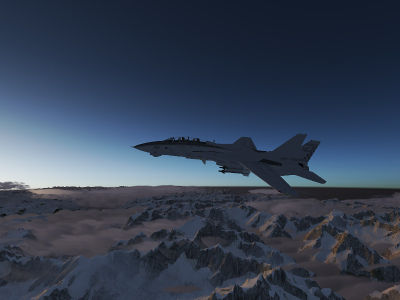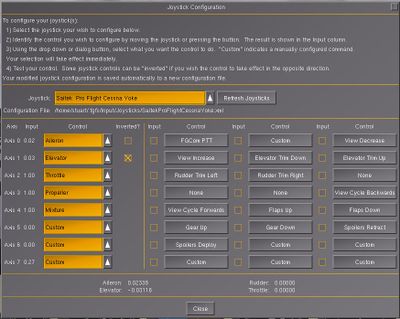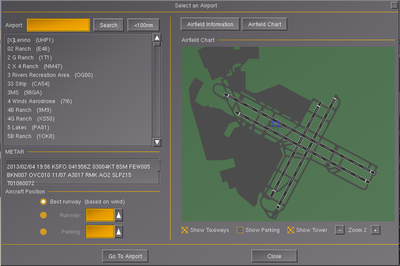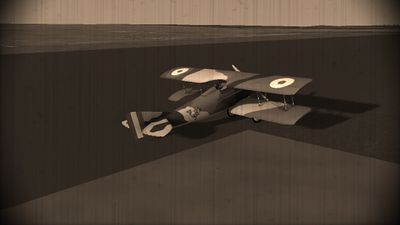Changelog 2.10
| ← Previous changelog | Next changelog → |
Available in: English, Espanol, Français Please help us translate in other languages!
FlightGear 2.10 Change Log
The FlightGear development team is happy to announce the v2.10 release of FlightGear, the free, open-source flight simulator. This new version contains many exciting new features, enhancements and bugfixes. Highlights in this release include improved usability, better terrain rendering and a fully scriptable 2D rendering system.
Founded in 1997, FlightGear is developed by a worldwide group of volunteers, brought together by a shared ambition to create the most realistic flight simulator possible that is free to use, modify and distribute. FlightGear is used all over the world by desktop flight simulator enthusiasts, for research in universities and for interactive exhibits in museums.
FlightGear features more than 400 aircraft, a worldwide scenery database, a multi-player environment, detailed sky modelling, a flexible and open aircraft modelling system, varied networking options, multiple display support, a powerful scripting language and an open architecture. Best of all, being open-source, the simulator is owned by the community and everyone is encouraged to contribute.
Download FlightGear v2.10 for free from FlightGear.org
FlightGear - Fly Free!
You can help us write the changelog for the upcoming FlightGear release at Next Changelog.
http://www.youtube.com/watch?v=MZVCmHgAX6Y
Major Enhancement in this release
Improved modularization
Architecture improvements introduced in this release mean that subsystems such as the traffic manager may be stopped and re-started dynamically within a simulation session. In future releases it is expected that more and more subsystems will support this function, making FG more scalable, and more flexible for distributed multi-machine simulators.
Atmospheric Light Scattering
Atmospheric light scattering is an alternative rendering framework, using exceptionally realistic environment-dependent fog and light computations for clouds and terrain. The simulation includes the following lighting models.
- Rayleigh, Mie and diffuse multiple scattering of light in the atmosphere, on haze and on clouds, for more realistic atmospheric lighting.
- Volumetric ground fog simulation, so fog varies in thickness both horizontally and vertically.
- Realistic ambient and diffuse light curves for sunset and sunrise conditions, making evening flights more realistic.
- Improved night VFR flying due to a moonlight illumination model.
Together with Advanced Weather, it functions as an integrated environment simulation in which the individual elements mutually influence each other. For instance
- Clouds and winds are influenced by the distribution of terrain elevation
- Prevailing winds, terrain slopes and stability of the lower atmosphere determine the shape of visible clouds
- Cloud layers and haze influence color and intensity of light reflections
- Winds influence wave patterns on water
- Light at sunrise and sunset is position and altitude dependent, allowing for phenomena such as Alpenglow or brightly illuminated high-altitude clouds while the ground is dark
For more powerful graphics cards, the framework includes procedural terrain texturing, including features such as the following.
- Non-tiling slope dependent terrain texturing, so scenery looks more featured but with fewer tiling artefacts.
- High resolution close-up texturing effects with up to 10 cm detail resolution and dynamically added bumpmap for low-level flight and better depth perception
- Environmental effects such as terrain wetness (including puddles), dustiness, mossiness, and snow cover. All adjustable by the user and respecting the terrain slope where appropriate.
Improved performance, reduced memory occupancy
Startup time and memory occupancy has been reduced by the implementation of a cache of navigation data. Further memory occupancy reductions have been made by improved random buildings. Frame-rates have been improved when using 3D clouds, particularly in overcast conditions.
Usability
Improving FlightGear's usability has been a focus for a number of developers for this release. Changes include:
- A new tool allowing joystick configuration in-sim, making it easier for new users to configure their joysticks as they wish and get flying!
- The Nasal Console has been improved to support copy/paste, making Nasal script development easier.
- The About dialog now includes additional system information, and the ability to copy information to the clipboard, making remote diagnosis of users problems faster and more straightforward.
- The Select Airport option now displays an overhead view of the selected airport, allowing users to preview their new location, and making it easier to choose the correct runway or parking position.
- In-sim checklists have been introduced for a number of aircraft.
- An in-sim documentation browser is included, so users can more easily browse all the documentation available in the base package.
- The weather configuration UIs have been combined and rationalized into a single weather UI, making it easier to select a nice VFR day, or a difficult CATIII approach.
- Flight path can now be displayed on the in-sim map.
- Instant replay may now be saved as a flight recorder, edited externally to add a commentary, and then replayed as a tutorial, with the user able to take control at any point.
- Multiplayer setup dialog now includes a dynamically generated list of active MP servers, making it even easier to take part in FlightGear's worldwide multi-player environment.
Internationalization
FlightGear continued to benefit from contributions from across the globe.
- The FlightGear Manual is now included in both English and French.
- System messages on startup are available in eight languages, just like the in-sim menu.
Flight Planning and Route Manager
- Route Manager now has better support for Navigraph procedures.
- Auto-generated SIDs and STARs are available for airports where real procedure data is not available. This generates plausible straight in approach and terminal waypoints based on the route course.
- The "flightplan" Nasal extension function has been improved, making it possible to retrieve a hash representation of the flight plan stored in the route manager. It is now possible to directly show a SVG image for each waypoint and connect them using OpenVG paths.
Canvas System
The "canvas" system is FlightGear's fully scriptable 2D rendering system, which makes it possible for users to easily create new instruments, HUDs and even dialogs and custom GUI widgets using FlightGear's built-in scripting language Nasal (which looks really similar to JavaScript). The Canvas can also be used for the creation of complex glass cockpit displays like navigational displays and other MFDs, none of this requires rebuilding FlightGear from source or writing C++ code.
Canvas improvements in this release include:
- Lazy updating/rendering to improve performance in situations where a texture doesn't need to be redrawn
- Creating GUI windows, including popup menus or menubars
- Native copy/paste via 2 new Nasal extension functions
- Nested canvases, where a canvas may contain images created by another canvas texture
- Window stacking
- raster images (vector images were already supported)
- Improved event handling GUI events using osgGA
- A new DOM-based event handling system
Rembrandt
- The Rembrandt renderer has been extended with a number of post-processing filters:
- Night vision including amplification grain and restrained field of view
- Cinema effect including:
- Vignetting
- Color shift, with Sepia as default value
- Radial distortion (barrel and pincushion distortion, with scale compensation)
- Lateral chromatic aberration (purple fringing)
- Film wear simulation
- Additional aircraft have been updated to make use of Rembrandt effects.
AI Improvements
- AI aircraft take-offs and landings are now more realistic.
- AI tankers can now be found using the HUD target marker.
Regional Textures
Building on the work in 2.8, the following areas now have region-specific texture-sets for more realistic terrain:
- Caribbean
- Western Europe
- Iceland
- Tropical South America
Highlighted new and improved aircraft
- The Boeing 777 has improved cockpit, PFD and NavDisplay.
- The Dassault Mirage 2000-5 has various instrumentation, HUD and stores added.
- The Douglas A-4F Skyhawk has an improved FDM and cockpit, including terrain-clearance radar and navigational computer.
- The Hawker Hurricane has improved FDM and cockpit.
- The Mudry Cap 10B, a classic French two-seat training aerobatic aircraft has been added by the PAF team.
Other
- Additional joysticks and rudder pedals are supported out-of-the-box.
- An interactive aircraft download page allows users to filter aircraft based on their level of completeness and accuracy, making it easier to discover the true gems of our extensive hangar.
Bug fixes
- See our bugtracker for an extensive, yet incomplete, list of the bugs fixed in this release.



